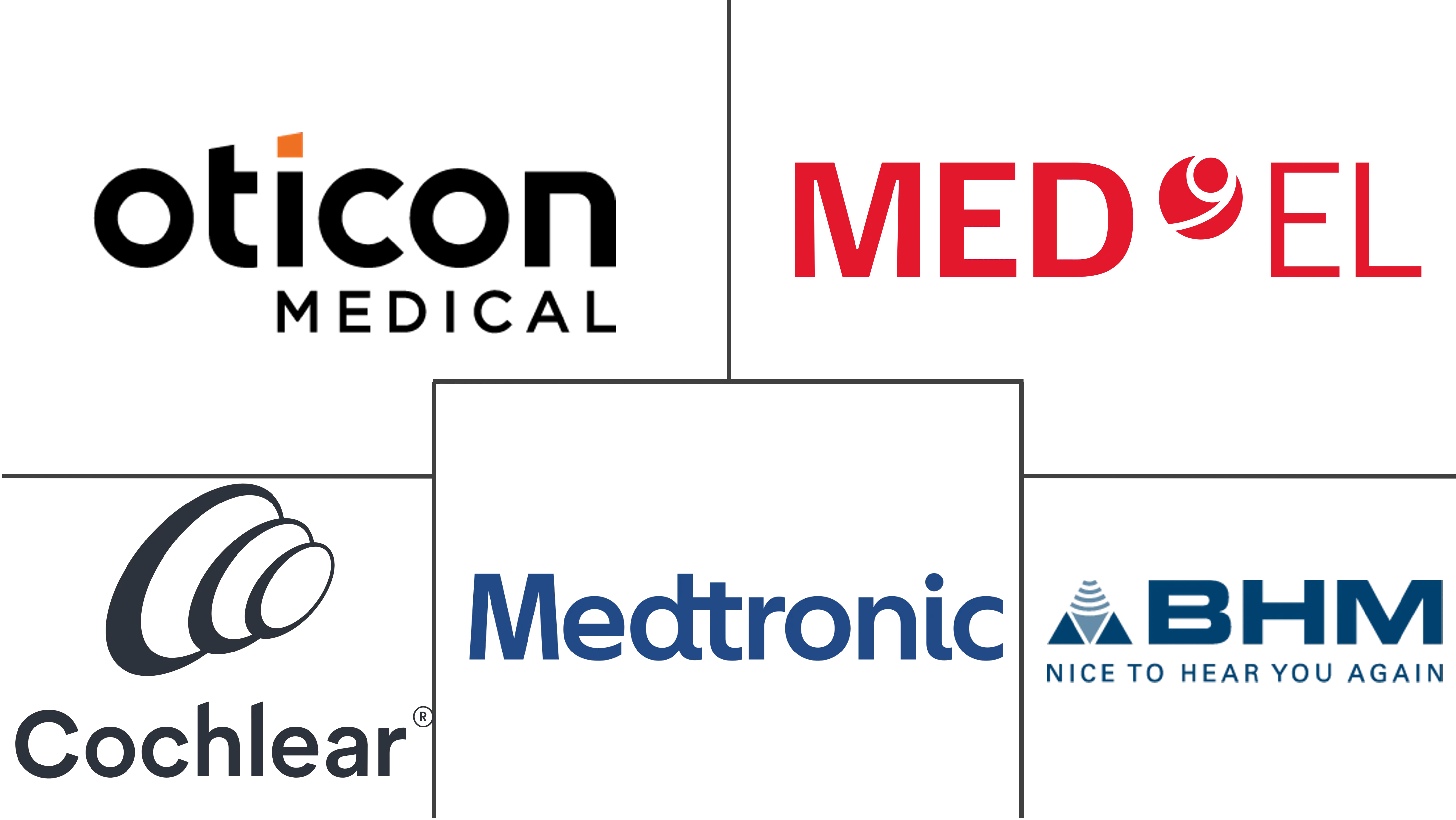Bone Conduction Hearing Aids Market Size and Share
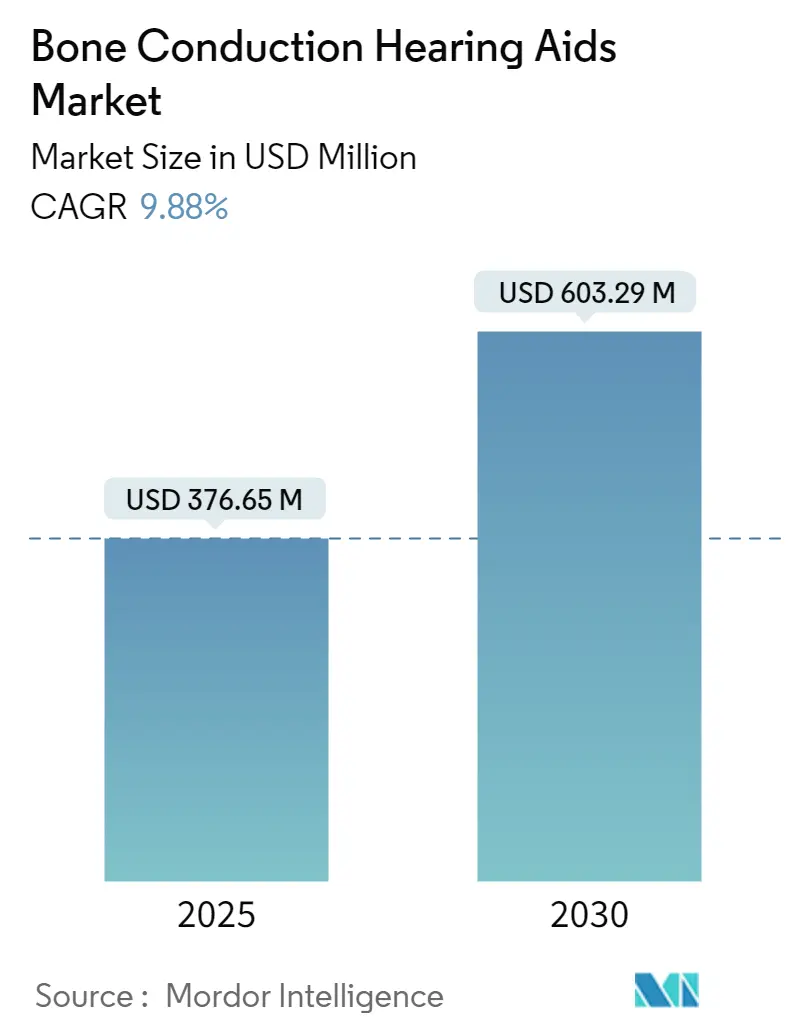
Bone Conduction Hearing Aids Market Analysis by Mordor Intelligence
The Bone Conduction Hearing Aids Market size is estimated at USD 376.65 million in 2025, and is expected to reach USD 603.29 million by 2030, at a CAGR of 9.88% during the forecast period (2025-2030).
Factors such as the technological advancements in bone-conduction hearing aids coupled with the growing incidence of hearing loss in geriatrics, increasing healthcare spending, and the high demand for bone-conduction hearing aids are expected to boost the market growth over the projected period.
The burden of hearing impairment in the geriatric population is relatively high, which is the key factor driving the market growth. Age-associated hearing loss is common among older adults. The World Health Organization (WHO) in February 2023, estimated that one in three people over 65 experience hearing loss, creating a significant need for hearing assistance. Additionally, an article published in JAMA Network in July 2023, indicated that 65.3% of adults aged 71 and older experienced hearing loss, with prevalence rising to 96.2% for those aged 90 and above. Among the oldest adults, 35.8% had mild, 38.8% moderate, and 9.6% severe hearing loss. Despite this high prevalence, only 29.2% utilized hearing aids. Hence, the high prevalence of hearing loss drives demand for diverse hearing solutions, with bone-conducting hearing aids offering a viable alternative for many users, thereby boosting market growth.
The increasing number of elderly individuals seeking effective solutions to manage their hearing loss directly propels the market for bone-conducting hearing aids, which are often more comfortable and less noticeable than traditional options. For instance, as per the United Nations Report 2023, Most least developed countries boasted a youthful age structure. Only 3.7% of their populations were aged 65 years or older, in contrast to 9% in other developing nations and 20% in developed countries in 2023 and it is projected that by 2050, the number of people aged 60 and older will reach 2.1 billion. This significant increase implies a larger segment of the population will be susceptible to age-related health issues, including hearing loss.
The growing technological advancements in bone conduction hearing aids are expected to increase their adoption among the population who are either suffering from hearing loss or are deaf. For instance, according to an article published in the Current Otorhinolaryngology Reports in November 2023, the percutaneous Osseointegrated devices offered the finest sound conduction and hearing fidelity. Also, the transcutaneous devices limit skin and wound complications, optimize bone conduction efficiency, and reduce the incidence of skin complications. Thus, the advantages offered by the advanced hearing aids are expected to increase its adoption, hence bolstering the market growth.
Furthermore, rising product launches and approvals also contribute to the market growth. For instance, in April 2024, WeHear developed non-surgical solutions tailored for individuals experiencing hearing loss. Their innovative bone conduction hearing aid, HearNU, achieved sales exceeding 11,500 units from 2021 to April 2024. The HearNU features a Bluetooth-connected wearable band that utilizes bone conduction technology to enhance its hearing aid capabilities. Such innovative launches in the market are expected to propel the market over the projected period.
As a result of the rising prevalence of hearing loss and advancements in bone-conduction hearing aid technology, the market is projected to expand during the forecast period. Nevertheless, challenges such as discomfort and pain associated with hearing aids, coupled with the premium pricing of bone-conduction variants, may impede the market's growth trajectory.
Global Bone Conduction Hearing Aids Market Trends and Insights
Bone Anchored Hearing Aids Segment is Expected to Witness Significant Growth Over the Forecast Period
The bone-anchored hearing aid (BAHA) is a surgically implanted device that aids individuals with hearing loss by transmitting sound vibrations directly to the inner part of the ear through the skull bone, bypassing specific auditory issues. These work best for people who have at least one inner ear that functions normally.
The prevalence of hearing loss among the geriatric population is growing, leading to the high demand for adult bone-anchored hearing aids. For instance, as per the National Council on Aging in November 2023, approximately 60.7 million Americans aged 12 and older were affected by hearing loss. Roughly 15.5% (or 44.1 million) of American adults aged 20 and older exhibit some degree of hearing impairment. Among those aged 65 and older, 31.1% face hearing challenges, and this figure rises to 40.3% for adults aged 75 and above. Thus, the high burden of hearing loss is expected to increase demand for hearing aids and is likely to drive the market for BAHA over the projected period.
Furthermore, several initiatives are taken to support the expansion of BAHA to meet the growing need of BAHA over the projected period. For instance, in June 2023, the United Kingdom Competition and Markets Authority (CMA) halted sales of the Pronto Bone Anchoring Hearing System (BAHS) due to concerns over market competition. This decision may foster market growth for BAHS by encouraging innovation and competition among manufacturers to develop alternative solutions. As companies strive to fill the gap left by Pronto's absence, it could lead to improved product offerings and potentially lower prices for consumers, thus expanding the overall market for bone-anchoring hearing systems.
Thus, the high burden of hearing loss and growing initiatives that support the meet growing need for BAHA are anticipated to bolster the segment growth over the forecast period.
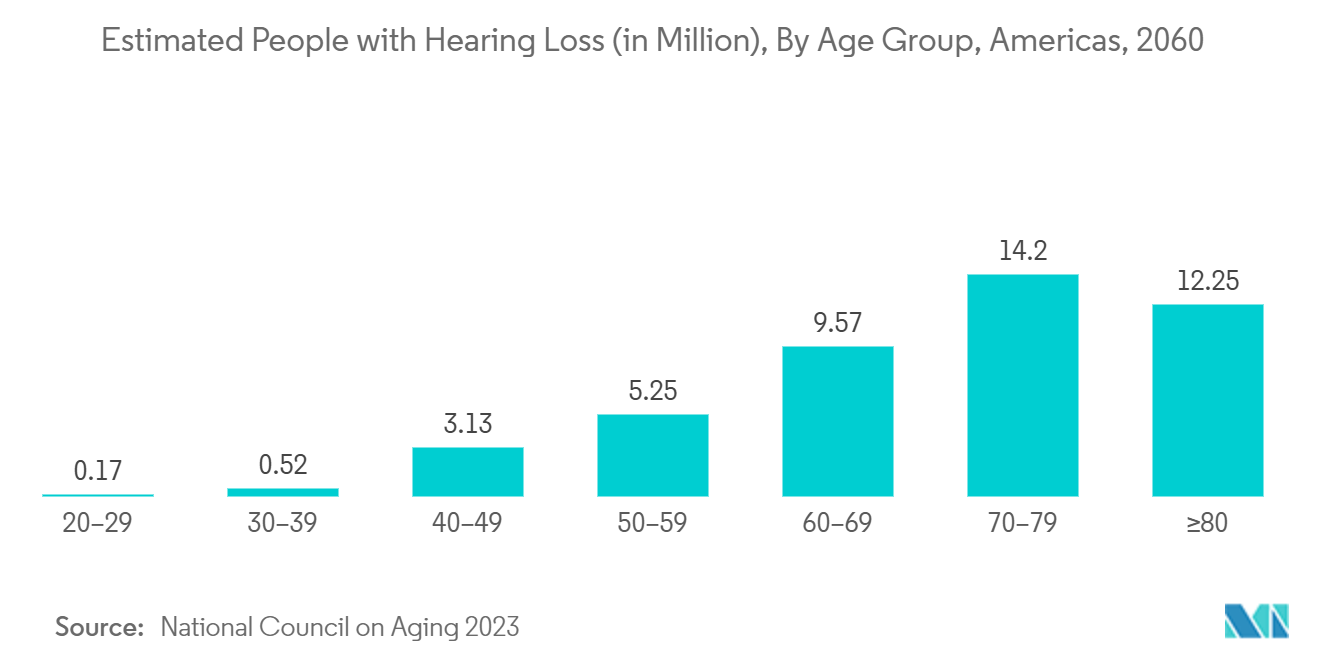
North America is Expected to Have the Significant Market Share Over the Forecast Period
North America is expected to hold a significant share of the market over the forecast period due to factors such as the rise in the incidence of hearing loss, the growing geriatric population, rising technological advancements, increasing product launches, and increasing government initiatives.
The growing incidence of hearing loss is expected to increase the demand for technologically advanced hearing aids, which is anticipated to fuel the market growth over the projected period. For instance, according to the data published by the PAHO, in March 2023, about 217 million people were living with hearing loss in the region of America, representing 21.52% of the total population in 2022, and this number is projected to reach 322 million by 2050. The increasing geriatric population in the region is also contributing to the increased demand for hearing aids as they are more likely to develop age-related hearing loss.
Furthermore, the rising company focuses on adopting various key strategies such as partnerships, collaborations, and others, as well as increasing product approvals and increasing the availability of technologically advanced products in the market, hence boosting the market growth. For instance, in August 2023, Cochlear Limited unveiled its next-generation Cochlear Osia System, engineered to enhance hearing outcomes for individuals with conductive hearing loss, mixed hearing loss, and single-sided sensorineural deafness (SSD). Notably, with the launch of the OSI300 Implant, it becomes the sole active bone conduction system enabling patients to safely undergo MRI scans at both 1.5 T and 3.0 T, all without necessitating surgery.
Increased awareness about the benefits of bone-conducting technology, driven by healthcare professionals and marketing efforts, has led more consumers to consider these devices as a legitimate option for hearing assistance. For instance, in March 2024, GN unveiled a campaign titled "The New Norm," targeting the misconceptions surrounding modern hearing aids. These misperceptions play a significant role in the prevalent issue of untreated hearing loss. Thus, such awareness programs will shift the focus of people towards bone-conduction hearing aids and their efficacies, which is expected to increase the adoptability of these devices and therapies, thus driving the market.
Therefore, with the increasing government funding, increasing incidences of hearing loss coupled with an aging population, and rising company activities, the studied market is expected to grow over the forecast period.
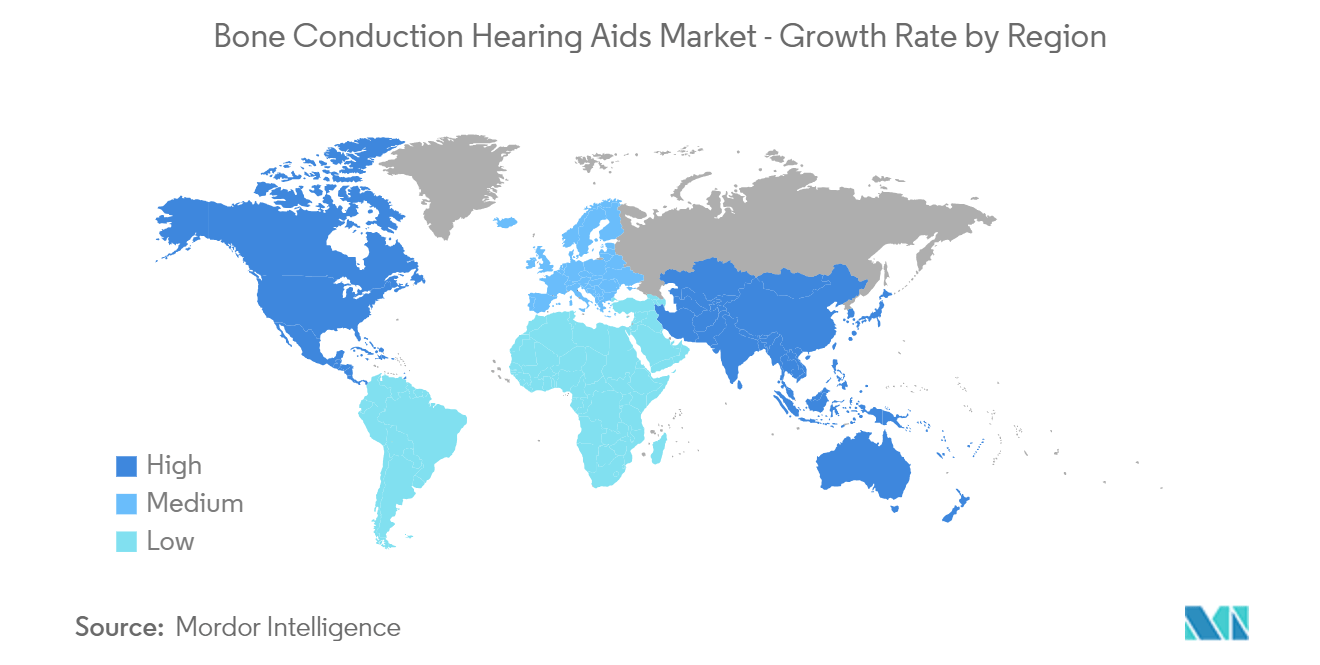
Competitive Landscape
The bone conduction hearing aids market is highly consolidated owing to the presence of a few key players. The market players are adopting several strategies such as product launches, mergers, acquisitions, and collaboration to expand their market share. Some of the key companies in the market are Cochlear Limited, Oticon Medical, Medtronic plc, MED-EL, and BHM-Tech Produktionsgesellschaft mbH among others.
Bone Conduction Hearing Aids Industry Leaders
-
Cochlear Limited
-
Oticon Medical
-
Medtronic plc
-
MED-EL
-
BHM-Tech Produktionsgesellschaft mbH
- *Disclaimer: Major Players sorted in no particular order
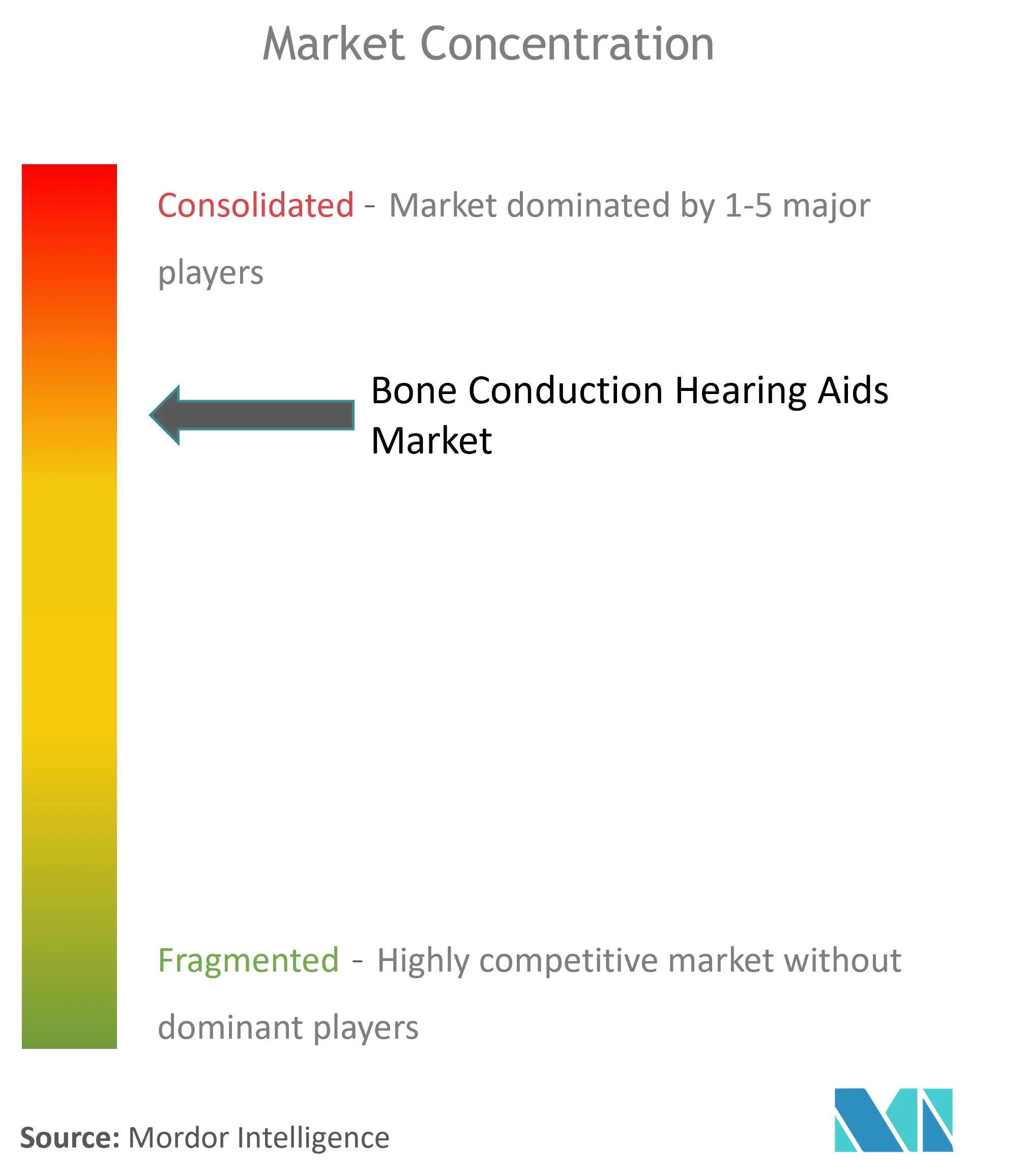
Recent Industry Developments
- July 2024: Oticon Medical has received clearance from the United State Food and Drug Administration (FDA) and the CE mark for its inaugural active transcutaneous bone conduction hearing system, named the Sentio System. The Sentio System not only offers the established advantages of the Ponto System but also introduces additional features in a transcutaneous format.
- July 2023: EssilorLuxottica, announced expansion into the hearing solutions market. The Group plans to introduce a new hearing technology combining eyeglasses and hearing aids to benefit the 1.25 billion consumers suffering from mild to moderate hearing loss.
Global Bone Conduction Hearing Aids Market Report Scope
Bone conduction is a reliable method of sound transmission that can be used to amplify hearing. Bone conduction hearing devices may be indicated when ear canal pathology precludes the use of a conventional hearing aid, as well as in cases of single-sided deafness. The device works by conducting the sound waves directly to the cochlea through the earbone.
The bone conduction hearing aids market is segmented by type, product, patient type, and geography. By type, the market is segmented as bone-anchored hearing aids and traditional bone conduction hearing aids. By product, the market is segmented into systems, accessories, and sound processors. By patient type, the market is segmented as children/pediatrics and adults. By geography, the market is segmented as North America, Europe, Asia-Pacific, Middle East and Africa, and South America. The market report also covers the estimated sizes and trends for 17 different countries across major regions globally.
The report offers the value (in USD) for the above segments.
| Bone Anchored Hearing Aids |
| Traditional Bone Conduction Hearing Aids |
| Systems |
| Accessories |
| Sound Processors |
| Children/Pediatrics |
| Adults |
| North America | United States |
| Canada | |
| Mexico | |
| Europe | Germany |
| United Kingdom | |
| France | |
| Italy | |
| Spain | |
| Rest of Europe | |
| Asia-Pacific | China |
| Japan | |
| India | |
| Australia | |
| South Korea | |
| Rest of Asia-Pacific | |
| Middle East and Africa | GCC |
| South Africa | |
| Rest of Middle East and Africa | |
| South America | Brazil |
| Argentina | |
| Rest of South America |
| By Type | Bone Anchored Hearing Aids | |
| Traditional Bone Conduction Hearing Aids | ||
| By Product | Systems | |
| Accessories | ||
| Sound Processors | ||
| Patient Type | Children/Pediatrics | |
| Adults | ||
| Geography | North America | United States |
| Canada | ||
| Mexico | ||
| Europe | Germany | |
| United Kingdom | ||
| France | ||
| Italy | ||
| Spain | ||
| Rest of Europe | ||
| Asia-Pacific | China | |
| Japan | ||
| India | ||
| Australia | ||
| South Korea | ||
| Rest of Asia-Pacific | ||
| Middle East and Africa | GCC | |
| South Africa | ||
| Rest of Middle East and Africa | ||
| South America | Brazil | |
| Argentina | ||
| Rest of South America | ||
Key Questions Answered in the Report
How big is the Bone Conduction Hearing Aids Market?
The Bone Conduction Hearing Aids Market size is expected to reach USD 376.65 million in 2025 and grow at a CAGR of 9.88% to reach USD 603.29 million by 2030.
What is the current Bone Conduction Hearing Aids Market size?
In 2025, the Bone Conduction Hearing Aids Market size is expected to reach USD 376.65 million.
Who are the key players in Bone Conduction Hearing Aids Market?
Cochlear Limited, Oticon Medical, Medtronic plc, MED-EL and BHM-Tech Produktionsgesellschaft mbH are the major companies operating in the Bone Conduction Hearing Aids Market.
Which is the fastest growing region in Bone Conduction Hearing Aids Market?
Asia Pacific is estimated to grow at the highest CAGR over the forecast period (2025-2030).
Which region has the biggest share in Bone Conduction Hearing Aids Market?
In 2025, the North America accounts for the largest market share in Bone Conduction Hearing Aids Market.
What years does this Bone Conduction Hearing Aids Market cover, and what was the market size in 2024?
In 2024, the Bone Conduction Hearing Aids Market size was estimated at USD 339.44 million. The report covers the Bone Conduction Hearing Aids Market historical market size for years: 2019, 2020, 2021, 2022, 2023 and 2024. The report also forecasts the Bone Conduction Hearing Aids Market size for years: 2025, 2026, 2027, 2028, 2029 and 2030.
Page last updated on:
Bone Conduction Hearing Aids Market Report
Statistics for the 2025 Bone Conduction Hearing Aids market share, size and revenue growth rate, created by Mordor Intelligence™ Industry Reports. Bone Conduction Hearing Aids analysis includes a market forecast outlook for 2025 to 2030 and historical overview. Get a sample of this industry analysis as a free report PDF download.
